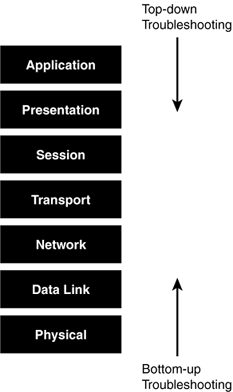Appendix A. Top-Down and Bottom-Up Troubleshooting
| Top-down and bottom-up troubleshooting are new terms that Cisco has added to this exam. Most of the time, when a user notices there is a problem, he or she notices a problem with the top layers of the OSI Reference model. This is because this is the point ”somewhere between the Application layer and the Session layer ”where the users interact with the applications they run. Sometimes your user's problem may manifest itself as a problem connecting to the network. Immediately you might go check the cabling, check the switch LEDs, check the back of the NIC on the user's PC to see if there is a good connection and lit LEDs, then check the switch to see if there are any errors such as CRC errors or auto sensing errors. This type of troubleshooting involves checking items from the bottom layers of the OSI Reference model, which are somewhere between the Physical layers and Data Link layer. If the problem is still not resolved, you will probably work your way up to the Network layer and check the IP addressing or other Network layer addressing to see if there is a problem there. Troubleshooting in this order within the OSI Reference model is an example of bottom-up troubleshooting . To get a better picture in your mind of how the OSI Reference model looks, take a look at Figure A.1. Figure A.1. The top-down and the bottom-up approaches to troubleshooting using the OSI Reference Model. Let's add another scenario to our fictitious troubleshooting problem. Suppose that the first thing we do is open a Command Prompt on our problem user's PC, and the IP address we ping (to another device in the network) replies with successful Pings. This is a good indication that all of the system's bottom layers are working just fine. In this situation we will probably reverse our troubleshooting method and work from the top down. We would then start checking for upper-layer service issues, such as authentication, database service issues, compression problems, encryption problems, and so on. By starting our troubleshooting at the upper layers and working our way down, we are performing top-down troubleshooting . |
EAN: 2147483647
Pages: 213
